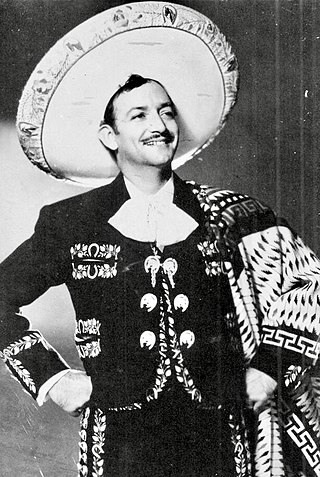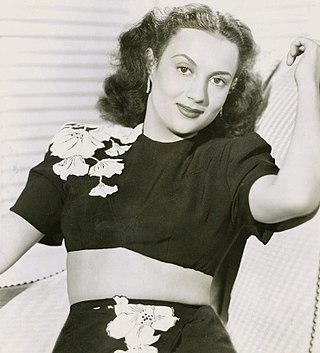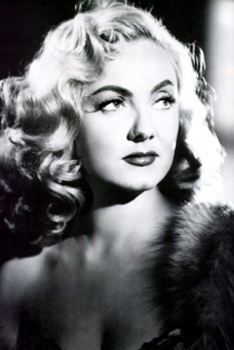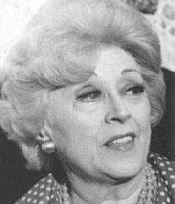Related Research Articles

Mexican cinema dates to the late nineteenth century during the rule of President Porfirio Díaz. Seeing a demonstration of short films in 1896, Díaz immediately saw the importance of documenting his presidency in order to present an ideal image of it. With the outbreak of the Mexican Revolution in 1910, Mexican and foreign makers of silent films seized the opportunity to document its leaders and events. From 1915 onward, Mexican cinema focused on narrative film.

Maria Antonieta Pons was a Cuban-born Mexican film actress and dancer. She was the first actress in the Rumberas films in the 1940s and 1950s, in the Golden Age of Mexican cinema. The Rumberas film genre offered a societal perspective on Mexico during the 40s-50s. It delved into the lives of women deemed as sinners or prostitutes, challenging the prevailing moral and social norms of their era.

Jorge Alberto Negrete Moreno was a Mexican singer and actor.

Maria del Pilar Cordero, better known as Mapy Cortés, was a Puerto Rican actress who participated in many films during the Golden Age of Mexican cinema, where she became one of the industry's most beloved and bankable stars of the 1940s.
The Golden Age of Mexican Cinema is a boom period in the history of Mexican cinema, which began in 1936 with the premiere of the film Allá en el Rancho Grande, and culminated in 1956.

Irasema Dilián was an actress. Born in Brazil to Polish parents, she began her film career in Italy, and appeared in Italian, Spanish and Mexican films.

Liceo Mexicano Japonés, A.C. ; Japanese: 社団法人日本メキシコ学院, romanized: Shadan Hōjin Nihon Mekishiko Gakuin, or 日墨学院, transl. Japan-Mexico Institute) is a Japanese school based in the Pedregal neighborhood of the Álvaro Obregón borough in southern Mexico City, Mexico.

María Elena Marqués Rangel was a Mexican actress and singer who was a star during the Golden Age of Mexican cinema in the 1940s and 1950s.

Amalia Isabel Rodríguez Carriera, known professionally as Amalia Aguilar, was a Cuban-Mexican dancer, actress and comedian.

Emelia Pérez Castellanos, known professionally as Ninón Sevilla, was a Cuban-Mexican actress and dancer.

Emilia Guiú Estivella was a Spanish-Mexican actress who appeared mainly in Mexican films, particularly in the 1940s and 1950s in the Golden Age of Mexican cinema. She made over 60 film appearances between 1943 and 2000 and typically played villain roles and "femme fatale". She also made a number of theatrical appearances.

Rosita Quintana was an Argentine-Mexican actress, singer and songwriter. She was one of the top leading ladies of the Golden Age of Mexican cinema. She starred in Luis Buñuel's Susana (1951) and musical films such as Serenata en México (1956) and Cuando México canta (1958). Her performances earned her acting awards from Mexico, Argentina, Russia, and Spain. In 2016, she received the Mexican Academy of Film Arts and Sciences' Golden Ariel Award for career achievement.
Emilio Tuero Cubillas, known as Emilio Tuero, was a Spanish-Mexican actor, producer, and singer. He was considered a popular star of the Golden Age of Mexican cinema.
Carlos Orellana Martínez was a Mexican actor, film director and screenwriter.
El verdugo de Sevilla is a 1942 Mexican film. It stars Sara García and Fernando Soler. It is based on a play by Pedro Muñoz Seca. It was made as part of a series of Mexican films set in Spain in the 1940s, such as Dos mexicanos en Sevilla (1942). Its title is a reference to The Barber of Seville, an 18th-century French play by Pierre Beaumarchais.

Elvira Catalina Quintana Molina was a Spanish-Mexican actress and singer.

Anita Blanch was a Spanish-born, Mexican actress, who worked in the Golden Age of Mexican cinema. She was nominated for an Ariel Award from the Mexican Academy of Film three times and won the Best Supporting Actress Award from Diosa de Plata in 1963.
Brave Pigeon is a 1961 Mexican film directed by Rogelio A. González with Rosita Quintana, Miguel Aceves Mejía and Sara García.
Conchita Gentil Arcos was a Mexican actress of the Golden Age of Mexican cinema as a character actress in supporting roles.
Florencio Castelló was a Spanish actor, known for participating in the Golden Age of Mexican cinema, acting alongside personalities of Mexican cinema such as Pedro Infante and Cantinflas. He usually played roles of Spaniard with an Andalusian accent.
References
- ↑ Rodríguez Terceño, José (2015). Creaciones audiovisuales actuales (in Spanish). Asociación Cultural y Científica Iberoamericana. p. 462. ISBN 9788415705352.
- ↑ Filmhistoria (in Spanish). Vol. 10. Barcelona: Promociones y Publicaciones Universitarias. 2000. p. 72.
- ↑ García Riera, Emilio (1986). Historia del cine mexicano (in Spanish). Secretaría de Educación Pública. p. 149. ISBN 9789682909412.